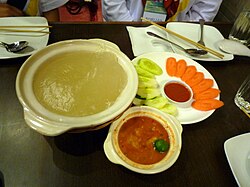Background
Ambuyat is the traditional food of the Bruneian Malay, Bisaya, Bajau, Kadazan-Dusun, and Lundayeh/Lun Bawang people in both the Interior Division and West Coast Division of Sabah and the Limbang Division of Sarawak, as well as the Malaysian federal territory of Labuan and the sultanate of Brunei, [5] [6] [7] where it is considered the national dish. [2] [8]
Ambuyat is eaten with a linked pair of bamboo chopsticks called chandas, by rolling the starch around the prongs and then dipping it into a sauce, [6] of which there are many varieties, including shrimp paste (sambal belacan), sambal tempoyak (chilli and fermented durian paste), sambal cincalok (chilli and fermented shrimp paste), and sambal binjai (a type of wild mango). [9] In the past, it was a dietary staple for the indigenous people of the region. [7]
In parts of Eastern Indonesia, there is a similar dish called papeda, which is usually served with stir-fried water spinach (kangkung), papaya flower buds, and a turmeric-tinged fish curry called kuah ikan kuning, flavoured with green chillies, lemongrass, and bay leaves. [9]
This page is based on this
Wikipedia article Text is available under the
CC BY-SA 4.0 license; additional terms may apply.
Images, videos and audio are available under their respective licenses.
